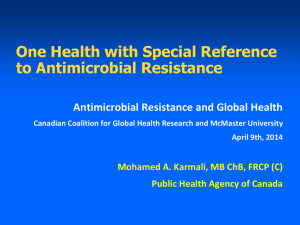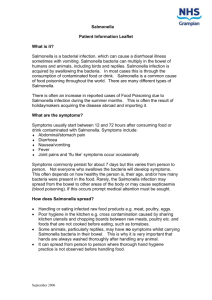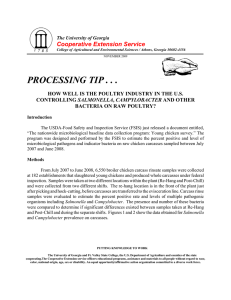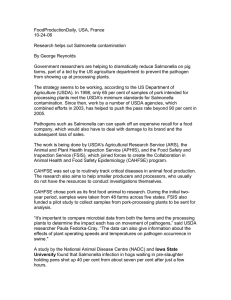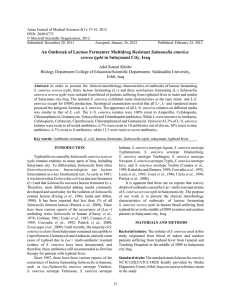Salmonella enterica cattle presented for slaughter in Honduras
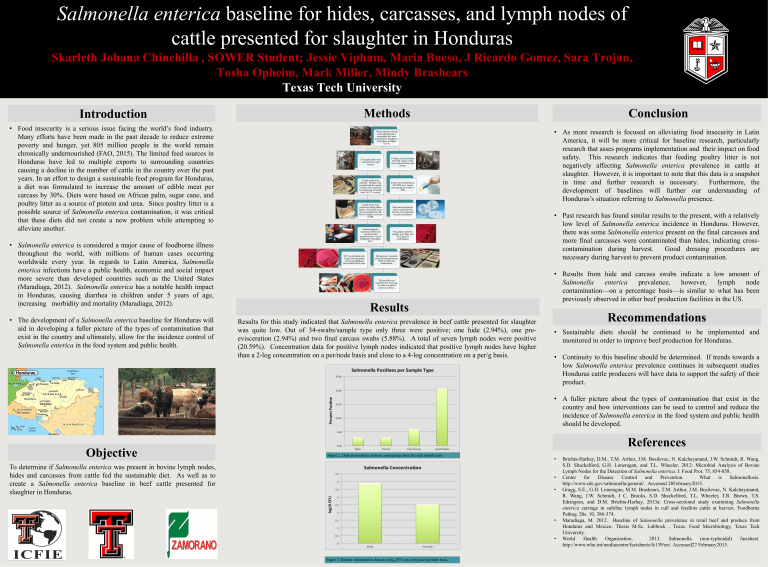
Salmonella enterica baseline for hides, carcasses, and lymph nodes of cattle presented for slaughter in Honduras
Skarleth Johana Chinchilla , SOWER Student; Jessie Vipham, Maria Bueso, J Ricardo Gomez, Sara Trojan,
Tosha Opheim, Mark Miller, Mindy Brashears
Texas Tech University
Introduction
•
Food insecurity is a serious issue facing the world’s food industry.
Many efforts have been made in the past decade to reduce extreme poverty and hunger, yet 805 million people in the world remain chronically undernourished (FAO, 2015). The limited feed sources in
Honduras have led to multiple exports to surrounding countries causing a decline in the number of cattle in the country over the past years. In an effort to design a sustainable feed program for Honduras, a diet was formulated to increase the amount of edible meat per carcass by 30%. Diets were based on African palm, sugar cane, and poultry litter as a source of protein and urea. Since poultry litter is a possible source of Salmonella enterica contamination, it was critical that these diets did not create a new problem while attempting to alleviate another.
•
Salmonella enterica is considered a major cause of foodborne illness throughout the world, with millions of human cases occurring worldwide every year. In regards to Latin America, Salmonella enterica infections have a public health, economic and social impact more severe than developed countries such as the United States
(Maradiaga, 2012).
Salmonella enterica has a notable health impact in Honduras, causing diarrhea in children under 5 years of age,
•
The development of a Salmonella enterica baseline for Honduras will aid in developing a fuller picture of the types of contamination that exist in the country and ultimately, allow for the incidence control of
Salmonella enterica in the food system and public health.
Objective
To determine if Salmonella enterica was present in bovine lymph nodes, hides and carcasses from cattle fed the sustainable diet. As well as to create a Salmonella enterica baseline in beef cattle presented for slaughter in Honduras.
Methods
34 beef animals that had been administered a sustainable diet were presented for slaughter in a Honduran slaughter facility.
34 Lymph nodes were collected from each carcass.
34 Hide, pre-evisceration and final carcass swabs were collected from each animal.
Lymph nodes were trimmed. Weights were recorded and the outside of nodes were sterilized by immersing in boiling water for 3-5 seconds.
Swabs were stomached at
230 RPM for 1 minute and transferred to 9ml of
TSB.
Lymph nodes were pulverized using rubber mallet. Pulverized nodes were homogenized with
80 ml of tryptic soy broth
(TSB).
Real-time polymerase chain reaction (PCR) analysis was conducted on each enrichment.
Immunomagnetic separation (IMS) was conducted and transferred into 3 ml of
Rappaport Vassiliadis
(RV).
Presumptive positive samples were plate onto
XLD agar for confirmation.
RV was streaked onto
Xylose Desoxycholate
(XLD) and Brilliant
Green Sulfa (BGS) agar.
Homogenate was pated using Enterobacteriaceae
(EB) petrifilm for enumeration.
EB petrifilm was transferred to XLD agar in order to confirm positive colonies.
Results
Results for this study indicated that Salmonella enterica prevalence in beef cattle presented for slaughter was quite low. Out of 34-swabs/sample type only three were positive; one hide (2.94%), one preevisceration (2.94%) and two final carcass swabs (5.88%). A total of seven lymph nodes were positive
(20.59%). Concentration data for positive lymph nodes indicated that positive lymph nodes have higher than a 2-log concentration on a per/node basis and close to a 4-log concentration on a per/g basis.
Figure 1. Depicts prevalence data on a percentage basis for each sample type.
Conclusion
•
As more research is focused on alleviating food insecurity in Latin
America, it will be more critical for baseline research, particularly research that asses programs implementation and their impact on food safety.
This research indicates that feeding poultry litter is not negatively affecting Salmonella enterica prevalence in cattle at slaughter. However, it is important to note that this data is a snapshot in time and further research is necessary.
Furthermore, the development of baselines will further our understanding of
Honduras’s situation referring to
Salmonella presence.
•
Past research has found similar results to the present, with a relatively low level of Salmonella enterica incidence in Honduras. However, there was some Salmonella enterica present on the final carcasses and more final carcasses were contaminated than hides, indicating crosscontamination during harvest.
Good dressing procedures are necessary during harvest to prevent product contamination.
•
Results from hide and carcass swabs indicate a low amount of
Salmonella enterica prevalence, however, lymph node contamination—on a percentage basis—is similar to what has been previously observed in other beef production facilities in the US.
Recommendations
•
Sustainable diets should be continued to be implemented and monitored in order to improve beef production for Honduras.
•
Continuity to this baseline should be determined. If trends towards a low Salmonella enterica prevalence continues in subsequent studies
Honduras cattle producers will have data to support the safety of their product.
•
A fuller picture about the types of contamination that exist in the country and how interventions can be used to control and reduce the incidence of Salmonella enterica in the food system and public health should be developed.
References
•
Brichta-Harhay, D.M., T.M. Arthur, J.M. Bosilevac, N. Kalchayanand, J.W. Schmidt, R. Wang,
S.D. Shackelford, G.H. Loneragan, and T.L. Wheeler, 2012: Microbial Analysis of Bovine
Lymph Nodes for the Detection of Salmonella enterica.
J. Food Prot. 75, 854-858.
•
Center for Disease Control and Prevention.
What is Salmonellosis.
http://www.cdc.gov/salmonella/general/. Accessed 28February2015.
•
Gragg, S.E., G.H. Loneragan, M.M. Brashears, T.M. Arthur, J.M. Bosilevac, N. Kalchayanand,
R. Wang, J.W. Schmidt, J C. Brooks, S.D. Shackelford, T.L. Wheeler, T.R. Brown, T.S.
Edrington, and D.M. Brichta-Harhay, 2013a: Cross-sectional study examining Salmonella enterica carriage in subiliac lymph nodes in cull and feedlots cattle at harvest. Foodborne
Pathog. Dis. 10, 386-374.
•
Maradiaga, M. 2012.
Baseline of Salmonella prevalence in retail beef and produce from
Honduras and Mexico. Thesis M.Sc. Lubbock , Texas. Food Microbiology, Texas Tech
•
University.
World Health Organization.
2013.
Salmonella (non-typhoidal) factsheet.
http://www.who.int/mediacentre/factsheets/fs139/en/. Accessed27 February2015.
Figure 2. Depicts concentration data on a log
10
CFU on a per/g and per/node basis.


